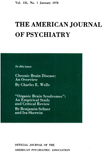Models of a heroin epidemic
Abstract
Heroin addiction may be considered an epidemic disease that is communicated by people who are addicted to the drug. It has been suggested that the most recent epidemic in the United States had its peak incidence in 1969. The age of heroin addicts entering treatment has increased systematically from 1973 to 1976 at a rate of less than one year of age per calendar year. This pattern is consistent with a moderate decline in a national heroin epidemic or a geographical migration of the epidemic from more to less populated areas. There are also seasonal trends in the age of admission to treatment.
Access content
To read the fulltext, please use one of the options below to sign in or purchase access.- Personal login
- Institutional Login
- Sign in via OpenAthens
- Register for access
-
Please login/register if you wish to pair your device and check access availability.
Not a subscriber?
PsychiatryOnline subscription options offer access to the DSM-5 library, books, journals, CME, and patient resources. This all-in-one virtual library provides psychiatrists and mental health professionals with key resources for diagnosis, treatment, research, and professional development.
Need more help? PsychiatryOnline Customer Service may be reached by emailing [email protected] or by calling 800-368-5777 (in the U.S.) or 703-907-7322 (outside the U.S.).



